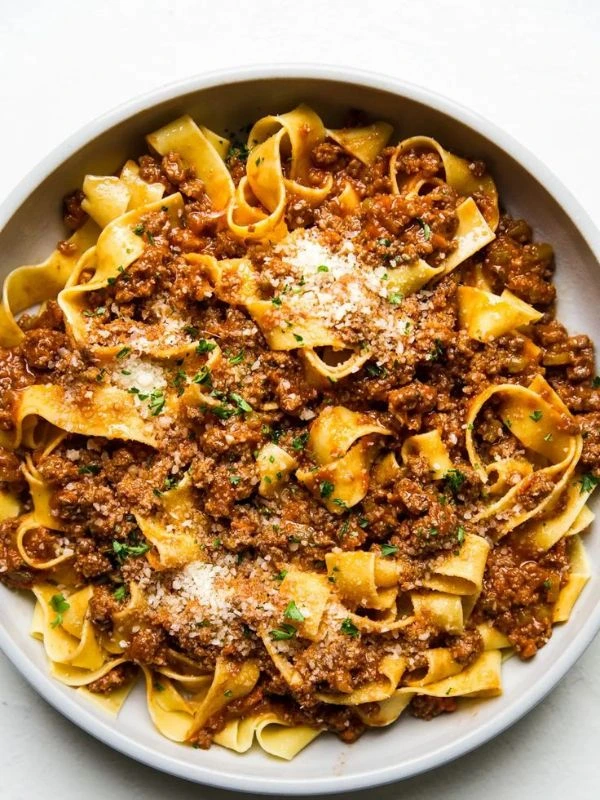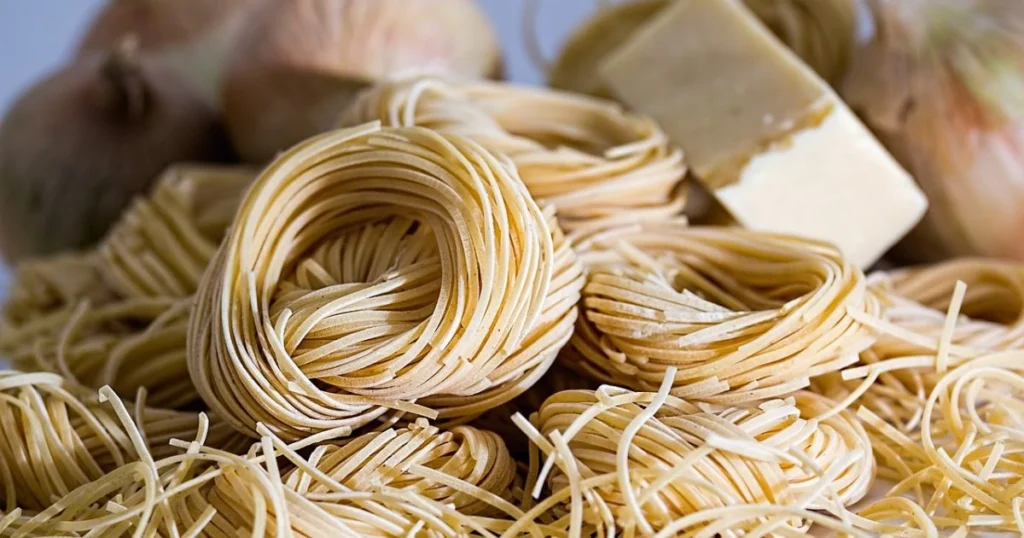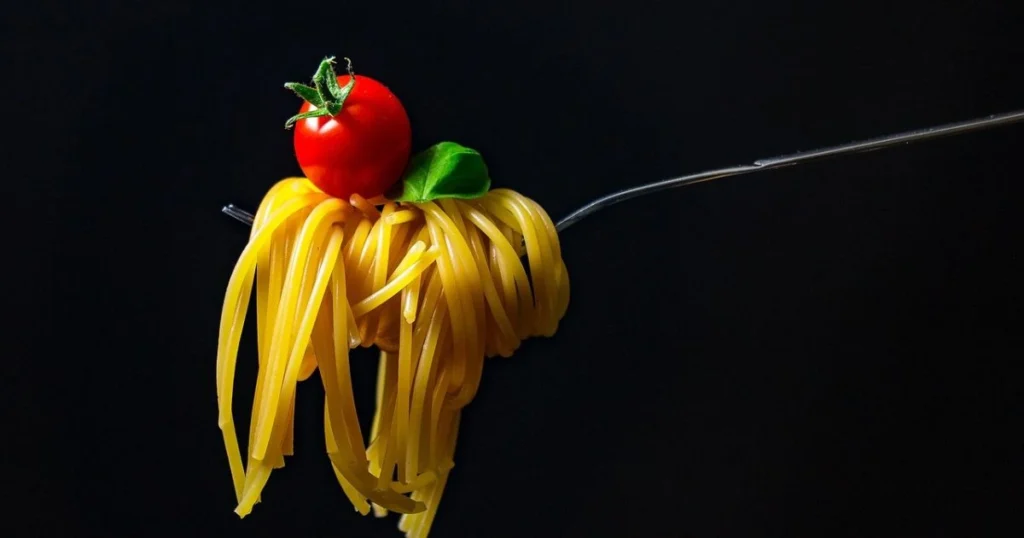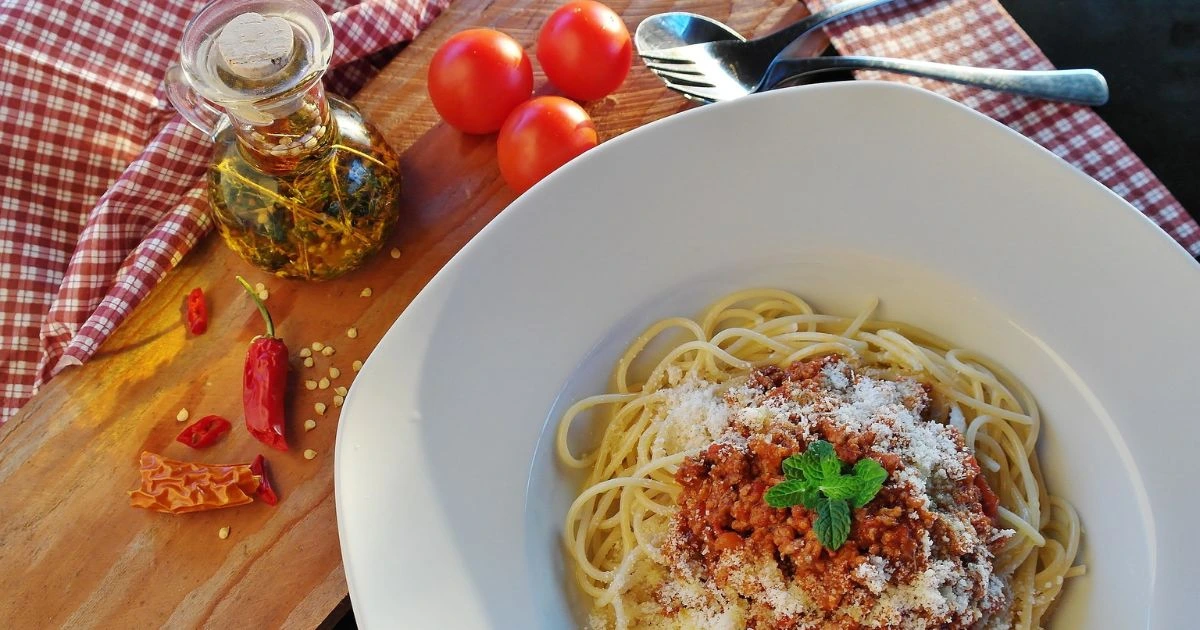Table of Contents
Bolognese Pappardelle Recipe
Experience the rich flavors of traditional Italian cuisine with our Bolognese Pappardelle recipe. This dish pairs wide, ribbon-like noodles with a slow-cooked Bolognese sauce. It’s full of depth and complexity. This hearty meal comes from Bologna, Italy, and is a true culinary masterpiece.

Key Takeaways
- Discover the rich history and evolution of the iconic Bolognese sauce
- Learn the essential ingredients and techniques for crafting an authentic Bolognese pappardelle
- Explore the best wine pairings and sauce reduction methods to elevate your dish
- Avoid common mistakes and master the art of serving and presenting Bolognese pappardelle
- Understand the proper storage and reheating guidelines for enjoying this Italian comfort food
Understanding the Rich History of Bolognese Sauce
Bolognese sauce is a beloved part of traditional Italian cuisine. It has a rich history that spans generations. This flavorful ragù comes from Bologna, Italy, and has changed over time.
Origins in Bologna, Italy
The history of bolognese sauce goes back to the 16th century. It was first recorded in Emilia-Romagna. The original sauce was a mix of ground meats, vegetables, and tomatoes.
Evolution Through Generations
- Over the years, Italian cooks have passed down the bolognese sauce recipe. Each generation has added their own twist.
- Changes include different meats, milk or cream, and herbs and spices. These additions have shaped the sauce.
- As bolognese sauce spread, it picked up regional flavors. This made it even more diverse.
Traditional vs. Modern Preparations
Traditional bolognese sauce is slow-cooked for hours. This lets the flavors blend well. Modern versions are quicker to make.
Some modern recipes add white wine or mushrooms. This gives the sauce a unique flavor.
| Traditional Bolognese | Modern Bolognese |
|---|---|
| Slow-simmered for hours | Quicker preparation |
| Blend of ground meats | May include additional ingredients like white wine or mushrooms |
| Tomatoes, milk, or cream | Tomatoes, milk, or cream |
Despite the differences, bolognese sauce’s rich history and cultural importance are undeniable. It remains a beloved dish in traditional Italian cuisine.

Essential Ingredients for Authentic Bolognese Pappardelle
Making a real bolognese pappardelle dish needs the right ingredients. You need top-notch meat and the perfect pappardelle pasta. Each part is key to a great Italian dish.
Quality Meat for Bolognese
The heart of a classic bolognese sauce is the meat. Use a mix of lean ground beef and pork. This mix gives great flavor and texture. Don’t use pre-ground meat, as it’s not as tasty.
Fresh Vegetables and Aromatics
- Onion: Finely chopped yellow or white onions provide a sweet and savory base for the sauce.
- Carrot: Grated or finely diced carrots add a touch of sweetness and vibrant color.
- Celery: Diced celery stalks lend a subtle bitterness and crunch to the sauce.
- Garlic: Minced or crushed garlic cloves infuse the sauce with their aromatic essence.
Herbs and Spices
- Fresh basil: Chiffonade or finely chopped, this herb adds a bright, herbal note.
- Dried oregano: A sprinkle of this earthy, slightly peppery spice enhances the overall flavor profile.
- Salt and pepper: Season to taste, adjusting as needed to balance the flavors.
Choose the best bolognese pappardelle ingredients for a great dish. The fresher and better the bolognese ingredients, the tastier your meal will be.
| Ingredient | Quantity | Notes |
|---|---|---|
| Ground beef | 1 lb | Lean or extra-lean preferred |
| Ground pork | 1 lb | Ideally from a quality source |
| Onion | 1 large | Finely chopped |
| Carrot | 2 medium | Grated or finely diced |
| Celery | 3 stalks | Finely diced |
| Garlic | 4 cloves | Minced or crushed |
| Fresh basil | 1/2 cup | Chiffonade or finely chopped |
| Dried oregano | 1 tsp | or to taste |
| Salt and pepper | to taste |
“The secret to a truly authentic bolognese sauce lies in the quality of the pappardelle pasta and the quality meat for bolognese used in its preparation.”

Kitchen Tools and Equipment You’ll Need
To make a real Bolognese pappardelle dish, you need a good kitchen. You’ll need the right cookware and utensils. These tools are key to getting the flavors and texture just right.
Essential Cookware
- A heavy-duty Dutch oven or large saucepan: This will be your workhorse for simmering the Bolognese sauce.
- A large stockpot: For boiling the pappardelle pasta.
- A sharp chef’s knife: For efficiently chopping and dicing your ingredients.
- A cutting board: Ensure you have a sturdy, non-slip surface for your prep work.
Recommended Utensils
- Wooden spoon or spatula: For gently stirring and scraping the bottom of the pan while the sauce simmers.
- Ladle: For transferring the cooked pasta from the pot to the sauce.
- Tongs: Useful for handling the pasta and ensuring even coating with the Bolognese sauce.
- Colander: To drain the cooked pappardelle noodles.
Optional but Helpful Tools
While not essential, some tools can make your Bolognese pappardelle prep easier and more fun:
- Pasta maker: For those who want to take their pasta-making skills to the next level, a pasta maker can help you roll out perfect pappardelle noodles.
- Food processor: Helpful for finely chopping or pureeing ingredients in the Bolognese sauce.
- Immersion blender: Allows you to achieve a smooth, velvety texture in the sauce without the need to transfer it to a traditional blender.
Having the right tools is crucial for a true Bolognese pappardelle dish. With the right cookware and utensils, you can master this Italian classic in your kitchen.
Selecting the Perfect Pappardelle Pasta
Choosing the right pasta is key to a great Bolognese pappardelle dish. You’ll find a variety of fresh and dried pappardelle, each with its own shape and texture. Exploring these options can be a fun journey in the kitchen.
Deciding between fresh and dried pappardelle is important. Fresh pasta is soft and velvety, which pairs well with rich sauces. Dried pasta is chewier and some people like it better. Both types can make your dish special in their own way.
The shape and quality of pappardelle matter too. Look for wide, flat noodles that catch the sauce well. Also, choose high-quality, artisanal pappardelle for the best taste.
| Pappardelle Pasta Types | Texture and Flavor | Recommended Uses |
|---|---|---|
| Fresh Pappardelle | Delicate, velvety | Pairs well with rich, creamy sauces |
| Dried Pappardelle | Hearty, chewy | Holds up well to heartier, tomato-based sauces |
| Artisanal, High-Quality Pappardelle | Exceptional flavor and texture | Elevates any pappardelle dish |
By picking the right pappardelle pasta, your Bolognese dish will shine. It will show off the beauty of Italian cooking.
Meat Selection and Preparation Tips
Making a true Italian Bolognese sauce needs careful meat selection and preparation. The right mix of meat for bolognese and seasoning can make this classic dish even better.
Choosing Quality Meats
For top-notch ground beef selection, choose a mix of ground beef and pork. The pork adds richness and flavor, while the beef gives it the heartiness it needs. Choose cuts with 80-85% fat for the best texture and juiciness.
Proper Grinding Techniques
- Grind whole cuts of meat yourself for the freshest taste.
- Use a food processor or meat grinder, but avoid overprocessing to keep it light.
- Go for a coarse grind to get that traditional Bolognese texture.
Seasoning Meat
Seasoning the meat is key to a true Bolognese’s complex flavors. Start with salt and black pepper. Try adding fennel seeds, dried oregano, or red pepper flakes for extra depth and heat.
| Ingredient | Quantity | Purpose |
|---|---|---|
| Ground Beef | 2 lbs | Provides the base flavor and texture |
| Ground Pork | 1 lb | Adds richness and depth of flavor |
| Salt | 1 tsp | Enhances overall seasoning |
| Black Pepper | 1/2 tsp | Provides subtle heat and complexity |
| Fennel Seeds | 1 tsp | Adds a distinctive Italian flavor profile |
By picking the right meat for bolognese, grinding it right, and seasoning it well, you’ll make a Bolognese sauce that will wow anyone. It’s a true Italian classic.
Step-by-Step Bolognese Pappardelle Instructions
Making the perfect bolognese recipe is a fun journey. It needs patience and focus. To make a real bolognese sauce and pair it with pappardelle pasta, just follow these steps:
- First, get all your ingredients ready. You’ll need ground beef, pancetta, onions, carrots, celery, garlic, tomato paste, canned tomatoes, red wine, milk, and herbs like basil and oregano.
- Start by cooking the pancetta in a big pot or Dutch oven over medium heat until it’s crispy. Take out the pancetta, ensuring the fat remains in the pot.
- Put the diced onions, carrots, and celery in the pot. Cook them until they’re soft and smell good, about 8-10 minutes.
- Stir in the minced garlic and sauté for an additional 2-3 minutes. Be careful not to burn the garlic.
- Put the ground beef in the pot and break it up with a spoon. Cook until it’s browned and done, about 10-12 minutes.
- Use some red wine to clean the pot, getting all the brown bits.
- Then, add the tomato paste, canned tomatoes, salt, pepper, and herbs. Let the sauce simmer gently.
- Lower the heat and let the bolognese sauce simmer for 45-60 minutes. Stir it now and then until it thickens and the flavors mix well.
- In the last 10 minutes, add a bit of milk to make the sauce creamy.
- While the sauce cooks, cook the pappardelle pasta until it’s al dente.
- Drain the pasta and mix it with the bolognese sauce. Make sure the pasta is well coated.
- Finally, serve the bolognese pappardelle hot. Top it with crispy pancetta, Parmesan cheese, and some chopped basil if you like.
By following these steps, you’ll make a delicious bolognese pappardelle dish. It will taste just like Italian food.
Wine Pairing and Sauce Reduction Techniques
To make your homemade bolognese pappardelle better, you need more than just a good recipe. Choosing the right wine and reducing the sauce can really boost the dish’s flavors.
Best Wine Choices
For wine with bolognese, pick a medium-bodied red that can handle the sauce’s richness. Here are some great choices:
- Chianti – Its bright acidity and subtle oak notes match the tomato and herb tastes in bolognese.
- Sangiovese – Being a key grape in Chianti, Sangiovese’s flavor profile pairs well with the dish.
- Barbera – This Italian red has high acidity and low tannins, making it ideal for wine pairing for bolognese.
Proper Reduction Methods
Reducing the sauce is key to enhancing bolognese flavor. By simmering it longer, you can intensify the flavors and achieve a smooth, shiny texture. Here are some sauce reduction tips:
- Use a wide, shallow pan to help the sauce evaporate faster.
- Simmer the sauce gently over medium-low heat, stirring now and then, until it’s as thick as you like.
- To add an extra layer of flavor, add a bit of red wine or beef stock while reducing.
Pairing your bolognese pappardelle with the right wine and using the right sauce reduction techniques will make your Italian feast unforgettable. It’s sure to wow your guests.
Common Mistakes to Avoid When Making Bolognese
Making Bolognese pappardelle is a fun cooking journey, but it comes with its own set of challenges. You might face bolognese cooking errors, pasta preparation mistakes, and sauce consistency issues. Knowing these common mistakes helps you make a tasty Bolognese dish every time.
One big bolognese cooking error is overcooking the meat, making it dry and crumbly. To avoid this, cook the ground beef or pork gently over medium heat. Also, many people don’t simmer the sauce long enough, making it watery. Let the Bolognese simmer for 2 to 3 hours to get that rich, velvety texture.
- Overcooked or dry meat
- Insufficient simmering time for the sauce
- Choosing the wrong type of pasta
- Neglecting to season the sauce properly
- Failing to reduce the sauce to the desired consistency
Another mistake is picking the wrong pasta. While pappardelle is the classic choice, some choose spaghetti or fettuccine. These can get lost in the bold Bolognese sauce. Also, not seasoning the sauce enough can make it taste flat. And not reducing the sauce enough can make it too thin.
| Common Mistake | Solution |
|---|---|
| Overcooked or dry meat | Brown the ground beef or pork gently over medium heat, taking care not to let it become too dry or tough. |
| Insufficient simmering time for the sauce | Allow the Bolognese to simmer for at least 2 to 3 hours, stirring occasionally, to develop the rich, velvety texture. |
| Choosing the wrong type of pasta | Opt for the traditional pappardelle noodle, as spaghetti or fettuccine can become overwhelmed by the robust Bolognese sauce. |
| Neglecting to season the sauce properly | Be sure to season the sauce with salt and pepper to ensure a balanced, flavorful profile. |
| Failing to reduce the sauce to the desired consistency | Simmer the sauce until it reaches the thick, velvety consistency that true Bolognese is known for. |
By avoiding these common mistakes and following best practices, you can make a delicious Bolognese pappardelle every time. With patience and attention to detail, you’ll create an authentic Italian dish in your kitchen.
Serving Suggestions and Presentation Tips
Improving your bolognese pappardelle dish is more than just great taste. How you present it can turn a tasty meal into a feast for the eyes. From the way you plate to the garnishes you choose, your presentation matters a lot.
Plating Techniques
For a stunning bolognese pappardelle presentation, focus on making it look good. Try placing the pappardelle in a nest shape on the plate. This lets the pasta flow beautifully. Then, add a lot of the rich bolognese sauce on top.
Garnishing Options
Enhance your bolognese pappardelle with garnishes that match its flavors and textures. A sprinkle of Parmesan cheese or some chopped parsley can brighten up the dish. For extra richness, add a dollop of ricotta or a drizzle of olive oil.
Temperature Considerations
It’s important to serve your bolognese pappardelle at the right temperature. The pasta should be hot, and the sauce should be smooth and warm. Serve it right away to keep the flavors and temperature perfect for your guests.
By paying attention to plating, garnishes, and temperature, you can make your bolognese pappardelle a feast for the eyes and taste buds. Your guests will be wowed by your cooking expertise.
Storage and Reheating Guidelines
Storing and reheating your homemade bolognese pappardelle right is key. It keeps the flavors and textures perfect. Follow these tips to enjoy your Italian dish as much on the second day as the first.
Storing Bolognese Sauce
Put the sauce in an airtight container or plastic bag to keep it fresh. It can be stored in the refrigerator for up to 4 days or in the freezer for up to 3 months. Thaw it in the fridge before reheating.
Reheating Pappardelle Pasta
To reheat, put the pasta in a saucepan with a bit of water or broth. Cover and heat on medium, stirring now and then, until it’s warm. This takes about 5-7 minutes. Don’t microwave it to avoid drying out the pasta.
Leftover Management Tips
- Keep the sauce and pasta in separate containers to stop the pasta from getting soggy.
- When reheating, add a bit of water or broth to the sauce to make it creamy again.
- Try using leftover bolognese in dishes like lasagna, shepherd’s pie, or stuffed peppers.
| Storage Method | Shelf Life |
|---|---|
| Refrigerated Bolognese Sauce | Up to 4 days |
| Frozen Bolognese Sauce | Up to 3 months |
| Refrigerated Pappardelle Pasta | Up to 3 days |
By storing and reheating your bolognese pappardelle correctly, you can enjoy it for days. Proper care keeps the dish delicious and authentic, even as leftovers.
Conclusion
Mastering bolognese pappardelle is a rewarding journey. It brings Italian flavors right to your kitchen. You now know how to make this beloved dish, impressing everyone.
Whether you’re experienced or new to Italian cooking, the secret is in the details. Use the best ingredients and tools. Follow the steps to make a dish that truly represents Italian heritage.
Keep improving your bolognese pappardelle recipe. Enjoy the process and make it your own. Try different pasta shapes and wine pairings. This way, you’ll discover more about Italian cooking and its traditions.
FAQ
What are the essential ingredients for making authentic bolognese pappardelle?
To make real bolognese pappardelle, you need top-notch ground beef or a mix of meats. Add onions, carrots, and celery for flavor. Don’t forget canned tomatoes, red wine, thyme, bay leaves, and salt and pepper.
Using the right meats and fresh ingredients is key. It makes the bolognese sauce rich and tasty.
Which pasta pairs best with Bolognese sauce?
Pappardelle, a wide, ribbon-like pasta, is perfect for bolognese sauce. Its thick texture holds up well to the meaty sauce. This lets the flavors mix together beautifully.
How do I properly reduce the bolognese sauce?
Reducing the sauce is crucial for the right consistency. Simmer it gently for a long time. This lets the liquid evaporate and the flavors intensify.
Slow cooking makes the sauce thick and velvety. It coats the pappardelle perfectly.
What wine pairs best with bolognese pappardelle?
A medium-bodied red wine, like Chianti or Sangiovese, pairs well with bolognese pappardelle. The wine’s acidity and tannins balance the sauce’s richness. Its fruity notes also match the savory flavors.
How can I avoid common mistakes when making bolognese pappardelle?
To avoid mistakes, use high-quality ingredients and the right meats. Cook the pasta just right and reduce the sauce enough. Season it well to your taste.
Following these tips helps you make a delicious, authentic bolognese pappardelle.

